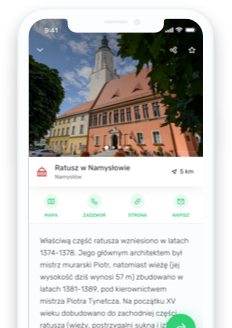The first mention of Namysłów Castle dates back to 1312. At the time, the castle was probably a wooden or wood-earth structure. In 1360, at the order of Charles IV, the King of Bohemia, construction works on the current castle began. Aside from the castle, the King also funded some of the town’s fortifications. The castle is situated on a small hill and was originally surrounded by a moat which was backfilled in the 19th century. In 1404, the castle hosted King Władysław Jagiełło, and in 1439 a treaty was signed there between the candidates to the throne of Bohemia: the 13-year-old Prince Kazimierz Jagiellończyk and Albrecht Habsburg.
In 1533, the castle was handed over as lien to the Town Council, which soon afterwards decided to expand it with an internal courtyard and a residential wing. In the 16th and early 17th century, the castle underwent further renovations. In 1703, it was taken over by the Teutonic Order. It sustained severe damage during the shelling of the town in 1741, but was eventually restored. After the secularization of the Teutonic Order in 1810, the utility buildings were dismantled, and 20 years later the castle became private property. At the end of the 19th century, the castle and the surrounding land were purchased by a German brewer, Augustin Haselbach, who significantly remodelled the interior of the building. The brewing traditions live on: the castle is now located on the premises of Namysłów brewery, which is why access to the building might be restricted.
In the castle courtyard, there is an ornamental well from the early 17th century. This round structure is located on a plinth and supported by three columns decorated with mascarons and floral motifs. The well is covered with an equally ornamental canopy.




 Powiat
Powiat Gmina
Gmina Gmina
Gmina Gmina
Gmina